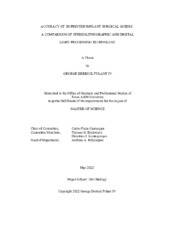| dc.description.abstract | Digital implant dentistry and dental applications of in-office 3D printing are rapidly becoming more prevalent in everyday practice. The way implant surgical guides are fabricated and fit in the mouth directly impact implant placement accuracy. There is a distinct lack of literature comparing these two printing methodologies with respect to guide accuracy and practical performance metrics. The primary aim of this work is to investigate two common 3D printing modalities currently in use for the fabrication of static implant surgical guides and quantitatively assess performance and if either modality has superior accuracy with respect to simulated implant placement. The secondary aims are to assess the real-world utility of each modality with respect to printing time, material cost analysis, printing success and guide fit.
A fully guided implant surgical plan was developed in CoDiagnostiX from DICOM and STL data. Sixty duplicated subject models were evenly allocated into two groups: SLA and DLP. Thirty surgical guides were fabricated for each group utilizing a Form 3B (SLA) and a Straumann P30 (DLP) 3D printer respectively. Guided implant placement was performed using 120 Straumann implant replicas and the implants were fixated with light cured Triad gel. Scan bodies were inserted into the implants and scanned with a Medit T710 benchtop scanner. This scan was evaluated in CoDiagnostix where the planned and actual implant positioning were compared. Printing metric data was recorded comparing printing time, material use and cost and print success throughout the study.
SLA printing had a statistically significant lower mean angular deviation (degrees) 0.77 ± 0.42 compared to DLP printing 1.02 ± 0.47 (p = 0.002). DLP printing had a statistically significant lower 3D offset at the implant neck (mm) 0.14 ± 0.07 compared to SLA printing 0.18 ± 0.11 (p = 0.017). No statistical difference was found between 3D offset at implant tip between printing groups (p = 0.768).
SLA Print success was 80% (8/10), DLP Print success was 100% (15/15). Cumulative SLA print time was 36 hours, 31 minutes, 25 seconds. Cumulative DLP print time was 5 hours, 39 minutes, 42 seconds. Both software calculated and actual print time/resin use, cost per guide, resin use per guide, print time per layer and print time per guide were statistically significant between printer type with DLP outperforming SLA in all printing performance metrics (p < 0.001).
While the present study does demonstrate statistical differences between SLA and DLP printing methodologies regarding implant placement accuracy, the clinical significance of this difference is questionable. The differences in printing metrics such as printing times, resin use and cost per guide does have real world ramifications and clinical relevance for the everyday use and utility of these two technologies in clinical practice. | |


